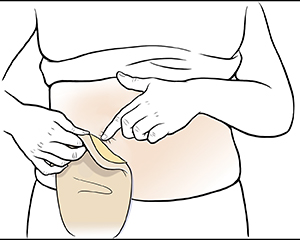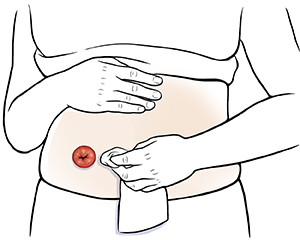Stool starts to pass from the stoma soon after surgery. At first, a nurse will change your pouch. But you’ll need to learn how to change it yourself before you go home. You will need to change your pouch 1 to 2 times a week. You will empty it more often, usually 6 to 8 times a day, when it is about 1/3 full. Don't let it get more than 1/2 full. To change your pouch, follow the steps below.
Start by gathering what you’ll need:
-
Plastic bags
-
Clean towel
-
Toilet paper
-
Extra skin protection, if desired
-
Soft washcloth
-
New pouch
Step 1. Remove the used pouch
-
If you use a drainable pouch, empty it first. Open the hook-and-loop closures. Or remove the clamp and set it aside.
-
Sit on or next to the toilet.
-
Start at the upper edge of the skin barrier. Carefully push the skin away from the barrier with 1 hand. Slowly peel back the skin barrier with the other hand.
-
Peel all the way around the skin barrier until the pouch comes off. Seal the pouch in a plastic bag. Then put it in a second plastic bag. Throw it away in a trash bin.
Step 2. Clean around the stoma
-
Wipe any stool off the skin around the stoma with toilet paper.
-
Clean the skin with warm water and a soft washcloth. Wash right up to the edge of the stoma.
-
Pat the skin dry with a clean towel.
-
Put on extra skin protection if desired. This may be a moisture barrier paste, cream, or powder.
Step 3. Put on the new pouch
-
If you don’t use a pouch with a precut skin barrier, size and cut the opening.
-
Slowly peel the backing off the barrier. Carefully place it over the stoma.
-
If you use a 2-piece pouch, snap the pouch onto the barrier. Start at the bottom. Work your fingers around the flange.
-
Press the barrier against the skin with your fingertips. Lay the palm of your hand over the barrier. Hold it in place for 45 seconds. This molds the barrier to your skin.
-
Secure the hook-and-loop closures shut. Or clamp the tail of the pouch.
Call your wound, ostomy, and continence nurse (WOCN)
Call your WOCN right away if:
-
The skin around the stoma is red, weepy, bleeding, or broken.
-
The skin around the stoma itches, burns, stings, or has white spots.
-
The stoma swells, changes color, or bleeds. If there is a large amount of bleeding, call 911 immediately.
-
The stoma becomes even with or sinks below the skin. Or it sticks up more than normal.




